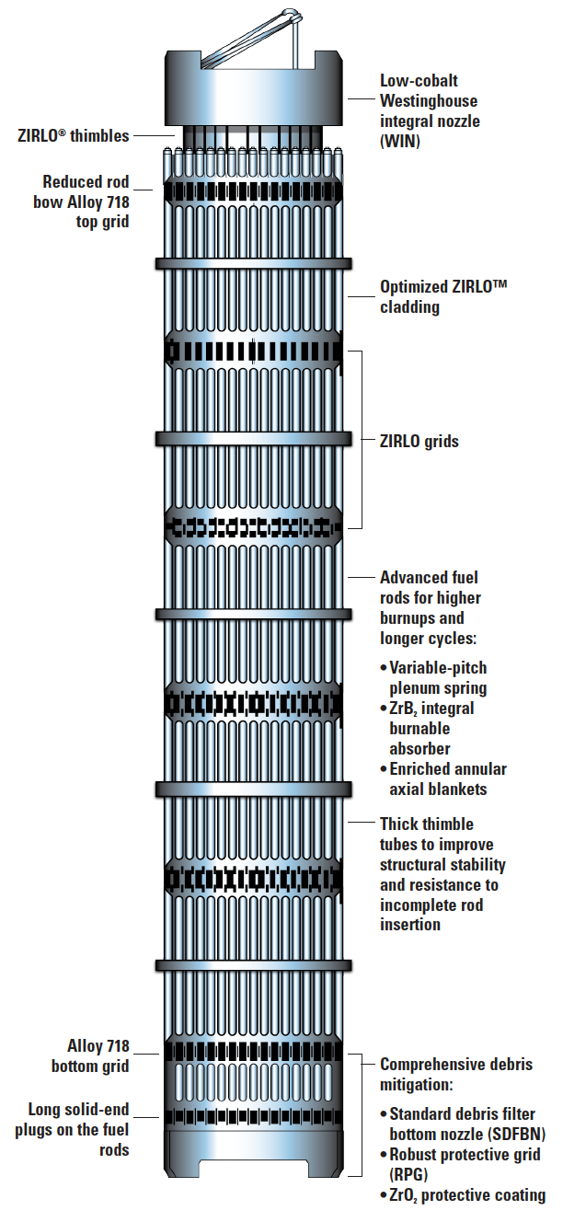Background
Westinghouse has more than 40 years of experience in design and manufacture of nuclear fuel assemblies that help utilities achieve exceptional fuel reliability and performance in today’s operating and commercial environment. The 17x17 robust fuel assembly (RFA-2) has demonstrated excellent fuel performance worldwide.

RFA-2 fuel design
Description
The RFA-2 fuel assembly can provide the lower cycle costs needed in today’s competitive market. With advanced features that provide increased fretting margin, heat transfer improvements, and enhanced debris mitigation, customers can feel confident about fuel performance and economics.
Fretting Margin
Endurance testing has shown that the RFA-2 mid grid improves grid-to-rod fretting performance four times more than previous designs. Its increased contact area with the rod is the primary contributor to the enhanced improvement in grid-to-rod fretting performance. In addition, its springs have less stiffness to reduce static and dynamic loads, and the edge geometry of the springs and dimples has been improved to reduce edge hardness.
Heat Transfer Improvements
The RFA-2 mid grid incorporates a high-performance mixing vane to optimize coolant mixing. This enhanced mixing improves departure from nucleate boiling (DNB) performance and reduces fuel rod hot spots, which are known to contribute to crud buildup on fuel rods and power shifts in the core. Heat transfer is further enhanced with high-performance intermediate flow mixing grids (IFMs). The use of three IFMs provides additional coolant mixing, improves thermal margin and reduces fuel rod surface temperatures for reduced oxidation and crud disposition.
ZrB2 Integral Fuel Burnable Absorber
Fuel cycle economics are important to all utilities and Westinghouse’s zirconium diboride (ZrB2) integral fuel burnable absorber (IFBA) is a key element in achieving improved fuel cycle costs. ZrB2 was specifically designed to allow utilities to achieve optimum uranium utilization over a multitude of loading patterns and operating schemes. IFBA rods enhance power distribution with no residual poison penalty. The benefits are increased neutron economy and flexibility, increased margins-to-peaking-factor limits, and lower fuel cycle and spent fuel costs. The Westinghouse ZrB2 IFBA offers superior predictability and economics as compared to other burnable absorbers.
Optimized ZIRLO™ As the nuclear industry pursues longer operating cycles with increased fuel discharge burnup and more aggressive fuel management, the corrosion performance requirements for nuclear fuel cladding become more demanding. The cladding material for the 17x17 RFA-2 is Optimized ZIRLO material, which has been demonstrated to have improved corrosion resistance compared with prior fuel cladding materials. The optimized tin level provides a reduced corrosion rate while maintaining the benefits of mechanical strength and resistance to accelerated corrosion from abnormal chemistry conditions. Reducing the associated corrosion buildup, and thus minimizing temperature feedback effects, provides additional margin to fuel rod internal pressure design criteria.
Enhanced Debris Mitigation
The RFA-2 uses three layers of protection, including a standardized debris filter bottom nozzle (SDFBN), robust protective grid and long solid-fuel-rod-bottom end plug, and fuel rod oxide coating.
The SDFBN provides the first level of defense against debris. Designed to mitigate debris-induced fuel rod fretting failures, the SDFBN has proven effective in enhancing reliability and reducing costs that could result from repair and replacement.
Located on top of the SDFBN is the robust protective grid (RPG). The RPG provides an additional debris barrier, resulting in increased fuel reliability. Any debris that passes
through the SDFBN will tend to be trapped in the RPG against the elongated solid-fuel-rod-bottom end plug. The final level of debris protection is provided by applying an oxide coating that shields the bottom six inches of each fuel rod, thus increasing wear resistance over uncoated cladding. Added together, this provides an improved level of debris mitigation.
Benefits
The RFA-2 fuel design is built on the proven experience and world-class leadership of Westinghouse in the design and manufacture of nuclear fuel. It provides the following benefits:
- Stiff structure for margin against fuel assembly distortion
- High contact-area mid grids for enhanced increased margins-to-fuel-rod fretting
- IFM grids that provide increased additional DNB margin
- High-performance mixing vane grids
- High-burnup advanced materials – ZIRLO® and Optimized ZIRLO
- Multiple layers of defense against debris
- Superior integral fuel burnable absorber for optimum fuel cycle economics
Experience
RFA and RFA-2 17x17 fuel has operated in plants in the United States, Spain, Belgium, France, Sweden and South Africa, with the first RFA reload regions in 1998 and RFA-2 in 2003. As of the end of 2014, either RFA or RFA-2 fuel has been used in 56 plants with over 400 reload regions and 22,000 assemblies with over 5.75 million fuel rods. RFA/RFA-2 fuel has been used in both three-loop and four-loop 17x17 plants with 12-foot fuel designs with and without IFM grids and 14-foot fuel designs without IFM grids over a range of coolant temperatures, flow rates and inlet flow distributions.


